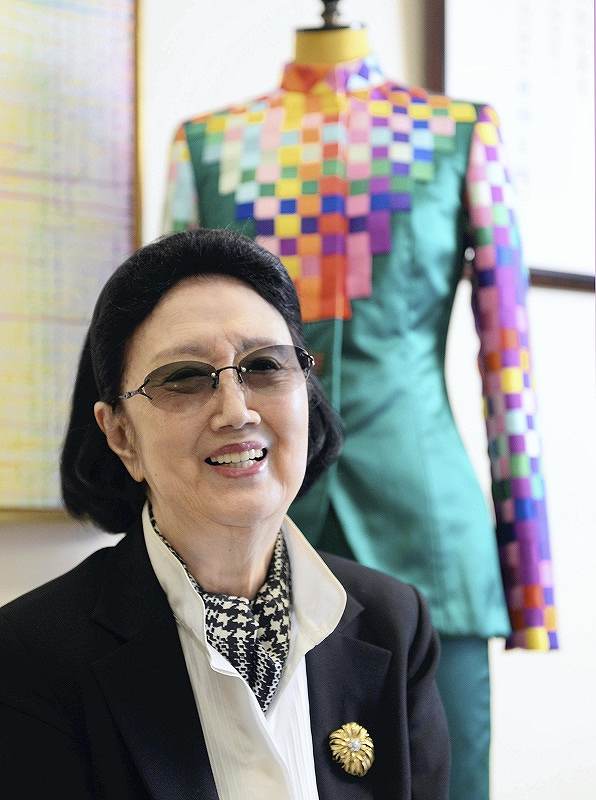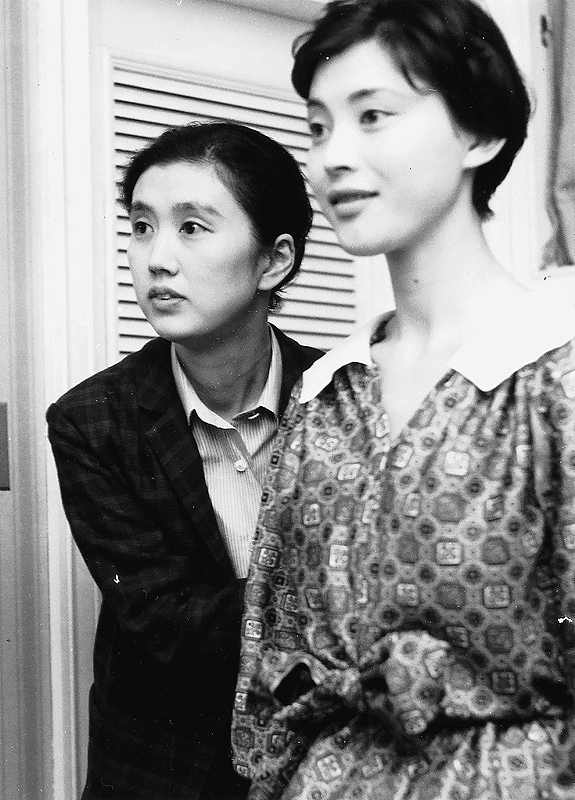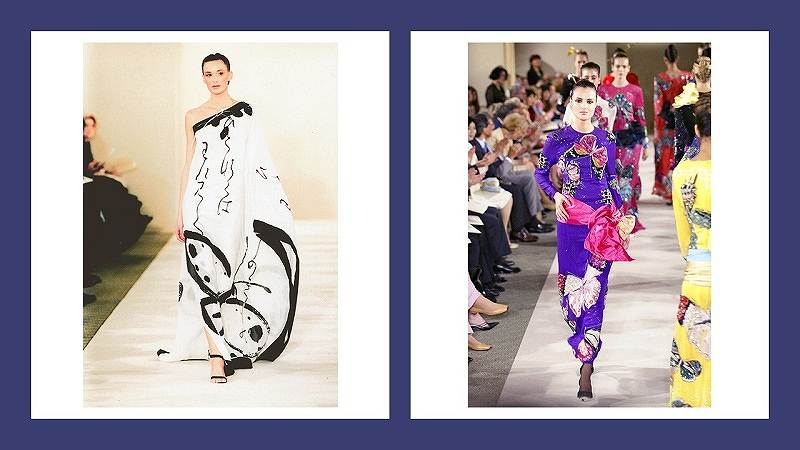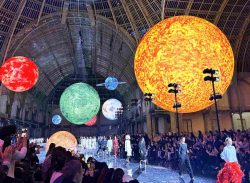
Hanae Mori during an interview in November 2014. “When I started working in Europe and the United States, I became very aware of Japan and traveled around the country to get to know it better,” Mori said.
12:07 JST, November 4, 2022
Hanae Mori, a fashion designer who died on Aug. 11 at the age of 96, is known for having designed many film costumes, in addition to haute couture clothing in Paris.
Mori opened her shop Hiyoshiya in Shinjuku, Tokyo, in 1951. While making a name for herself as an up-and-coming fashion designer, she attracted the attention of people connected to Nikkatsu Corp., a major film production company.
At that time, going to movie theaters was the most popular form of entertainment for many Japanese people.
More of Mori’s film costumes would end up going to famous actress Mariko Okada than anyone else.
Okada first met Mori shortly after making her debut through a person involved in film production, who suggested to Okada that she work with Mori, who had also just debuted.
“She was a little older than me and more like an ordinary woman than a fashion designer,” Okada said, recalling their first meeting. “She seemed low-key.”
The film-making process around that time had Mori reading each film script, then holding meetings with the director and actors, and starting design work after they had reached a consensus.
“We exchanged ideas about what the costume should be and she did the basting [loose stitching] again and again to make adjustments before the final sewing,” Okada said. “Mori read the script thoroughly no matter how soon she had to finish the costumes and precisely expressed each character through her costumes.”
During filming, actors often had to change clothes quickly. As pullover clothing would mess up their hair and makeup, Mori devised designs with side and back openings to allow them to change more easily.
Once, Okada brought a pair of pants to Mori and said that “they were hard to put on.” Mori examined them closely and then began to unpick the seams in front of Okada.
“She even started over by making a pattern. I was so surprised,” Okada said.
As both of them were very busy with their work, it was extremely difficult for them to find time to do the basting.

Mariko Okada, right, with Mori while basting clothes
Okada visited Mori’s shop on her way home from a film studio for stitching, and afterward, they sometimes had dinner together late at night.
Okada said she thoroughly enjoyed it.
One of Okada’s most unforgettable films was “Onna no mizuumi” (Woman of the Lake) (1966), an adaptation of Yasunari Kawabata’s novel of the same title, directed by Yoshishige Yoshida, who is Okada’s husband.
For the lead character, played by Okada, Mori made two one-piece dresses of the same design, one of them in black and the other in white. Okada changed between them depending on the scene.
“The costumes were just so modern and cool. I felt like they were creating a new era,” Okada said.
Okada had Mori make everyday clothes for her and even her wedding dress.
“An actress must always look perfect from every angle,” Okada said. “I needed Mori.”
Mori also designed many costumes for other leading film actresses at the time, including Mie Kitahara, Yoko Minamida, and Yumeji Tsukioka. It is not known exactly how many films she worked on.
Regarding her film-related works, Mori said: “I was making costumes for several films at the same time,” “My name is not in the film credits,” and “I was so busy that I didn’t have time to enjoy watching the finished films in movie theaters.”
Although designing and making costumes was considered a backseat role, her name was listed as a costume designer for the first time in the credits for Yuzo Kawashima’s film “Fusen” (The Balloon) in 1956.
“The costumes designed by Mori were superbly and meticulously crafted down to the finest detail and they were also easy to wear. That’s why so many actresses asked Mori to make clothes for their private lives too,” says Risa Hirota, chief curator of the Iwami Art Museum, located in Shimane Prefecture.
The museum has a large collection of Mori’s works. Hirota is conducting research on them.
“As we can see from the neckline, sleeve length and other elements of each item, Mori thought a lot about how to make it suitable and look beautiful when worn by the actress for her film character,” she said. “They also express Mori’s unique style in an exquisitely well-balanced manner.”
“This experience in costume making may have paved the way for her to make haute couture pieces in Paris, the capital of high-end fashion,” Hirota added.
Mori worked hard to make film costumes even by cutting down on her sleep, while also designing women’s wear. The work developed her powers of expression, her technique and her spirit, which built the foundation for her success on the world stage.
Seeing Japan from Paris
I first interviewed Mori in 1992. While chatting, she said, “If you go to Paris, you will see the world.”
Mori first experienced “the world” in 1961 during her trip to Paris and New York. This trip made her decide to expand her activities overseas.
The next year, she wrote an essay titled “Nihon wa Nihon” (Japan is Japan) for the Japanese fashion magazine Soen.
She wrote, “People in other countries do not know that there are fashion designers in Japan,” criticizing the Japanese apparel industry for always imitating Western designs. “I want Japanese people to know that Japanese silk and clothes are popular products that can earn foreign money and promote Japanese artistic qualities overseas.”
She was probably desperate to change the landscape at that time.
While active in the haute couture business in Paris, Mori cherished her roots in Japan. She recognized the importance of her heritage as local French people told her to make the most of her roots. The world was also a place from which to look at Japan from the outside.
When Yumi Katsura, a bridal fashion designer, asked Mori for her advice before entering the Paris market, Mori said to her: “Do what others are not doing. You must show your individuality.”
In 2003, Katsura held her first haute couture show in Paris. To her surprise, on the morning of the show, Mori came to the venue with a bouquet of flowers.
Katsura said: “Fashion shows are a battlefield for designers. Mori was holding her own show the next day. Even so, she came to encourage me and said, ‘Let’s do our best as Japanese.’ She always felt responsible for giving others a good impression of Japan.”
Mori continued to express not only her own identity but also a Japanese identity.
Woven labels with the name “Mori Hanae” written in hiragana are sewn inside of haute couture clothes for her customers across the world. This may have been one way she sought to express “Japan.”

A dress with a bold butterfly design painted by brush for Mori’s 2002 Spring / Summer collection, left, Mori’s last haute couture collection on the runway in July 2004
"Culture" POPULAR ARTICLE
-

Van Cleef & Arpels Dazzles with Art Deco Artisanry at Tokyo Exhibit
-

Disney’s ‘Twisted-Wonderland’ Animated Series Puts Villains in Spotlight: New Show Features School Inspired by Classic Disney Films
-

Ayumi Hamasaki’s Shanghai Concert Canceled Day Before Schedule as Part of Beijing Backlash
-

‘The World Masterpiece Theater Series’ Celebrates 50 Years; Animator Looks Back on Creating Anime Classics
-

Popularity of Piggy Banks Across Time and Place Seen at Bank’s Museum of Money Boxes in Hyogo Pref.
JN ACCESS RANKING
-

Tokyo Economic Security Forum to Hold Inaugural Meeting Amid Tense Global Environment
-

Keidanren Chairman Yoshinobu Tsutsui Visits Kashiwazaki-Kariwa Nuclear Power Plant; Inspects New Emergency Safety System
-

Imports of Rare Earths from China Facing Delays, May Be Caused by Deterioration of Japan-China Relations
-

University of Tokyo Professor Discusses Japanese Economic Security in Interview Ahead of Forum
-

Japan Pulls out of Vietnam Nuclear Project, Complicating Hanoi’s Power Plans
























